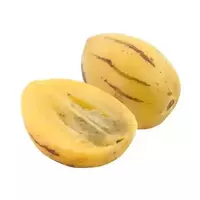Pepino

Pepino, which is a member of the nightshade family and refers to perennial evergreen shrubs, has more than one name. Sweet cucumber or melon pear - these names fully reveal the essence of this fruit. The leathery leaves of the plant are oblong in shape, and the pepino flowers are colored blue-purple. South America is considered the birthplace of pepino, where it is cultivated for the sake of obtaining sweet fruits suitable for food, the taste and aroma of which resemble melon.
Pepino is often mistakenly called fruit, probably due to the considerable size of the fruit, which varies greatly - from 50 to 700 grams. Meanwhile, pepino is a berry that is ready to be harvested once the size of the goose egg is reached, as well as when its color takes on a cream or pale yellow color.
Harvesting crops from branches should be very careful and it is important to do this in a timely manner, since if overripe fruits remain on the bush, they will soon lose their excellent taste. On one plant, pepino berries, as a rule, mature at different times, and therefore have to harvest more than once a season.
Pepino fruits can have a completely diverse shape - oblong, rounded, pear-shaped and flattened. Ripe berries are colored, as mentioned above, cream or lemon yellow. By the way, on the peel of some varieties of pepino there are often lilac-purple longitudinal stripes or speckles.
The light yellow flesh of mature pepino is characterized by a rich exotic aroma, increased juiciness and sour-sweet taste. A pleasant rich taste, which is characterized by a small sourness, is due to the content of a large amount of ascorbic acid in pepino fruits.
In South America and Japan, pepino is most often eaten fresh as a light dessert. The skin of the berry does not differ in special taste, so it is customary to remove it. The flesh of the fruit contains a small amount of seeds, however, despite the fact that it will not be difficult to extract them, some people prefer to eat them.
In New Zealand, pepino is usually added to soups, dishes from meat, fish and other seafood, sauces, a variety of desserts, as well as fruit salads. Berries can be stored for future use: dry, freeze or preserve. In addition, unripe fruits are often used, from which vegetable salads are prepared, and also pickled as ordinary cucumbers. Pepino makes excellent jams, jam, canned food, compotes and baby food, mainly mashed potatoes.
pepino 80 kCal
Energy value of pepino (Ratio of proteins, fats, carbohydrates - ju):
Proteins: 0 g (~ 0 kCal)
Fats: 0 g (~ 0 kCal)
Carbohydrates: 22g (~ 88kCal)
Energy ratio (bj | y): 0% | 0% | 110%
 Español
Español Français
Français Português
Português Русский
Русский 简体中文
简体中文 繁體中文
繁體中文 日本語
日本語 한국어
한국어 العربية
العربية Türkçe
Türkçe Қазақ
Қазақ Deutsch
Deutsch Italiano
Italiano Українська
Українська
